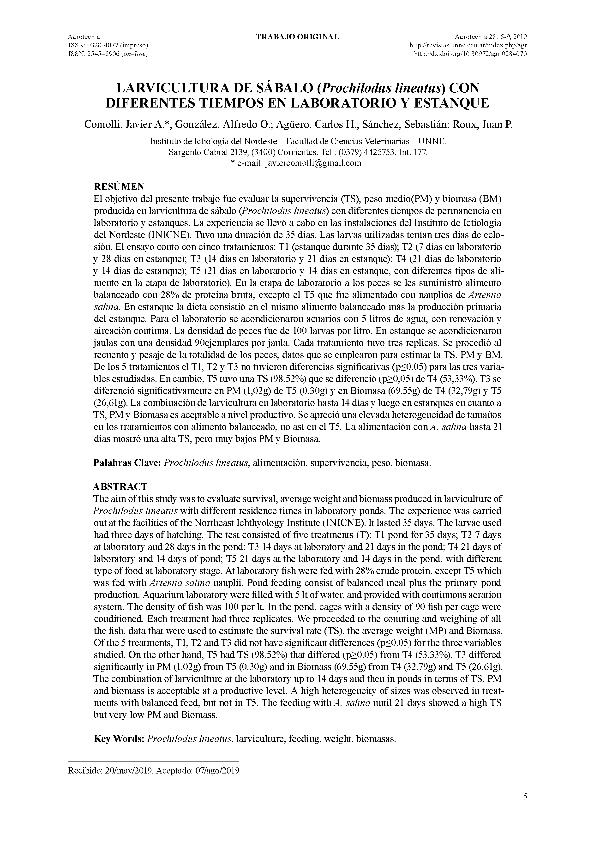Artículo
El objetivo del presente trabajo fue evaluar la supervivencia (TS), peso medio(PM) y biomasa (BM) producida en larvicultura de sábalo (Prochilodus lineatus) con diferentes tiempos de permanencia en laboratorio y estanques. La experiencia se llevó a cabo en las instalaciones del Instituto de Ictiología del Nordeste (INICNE). Tuvo una duración de 35 días. Las larvas utilizadas tenían tres días de eclosión. El ensayo conto con cinco tratamientos: T1 (estanque durante 35 días); T2 (7 días en laboratorio y 28 días en estanque); T3 (14 días en laboratorio y 21 días en estanque); T4 (21 días de laboratorio y 14 días de estanque); T5 (21 días en laboratorio y 14 días en estanque, con diferentes tipos de alimento en la etapa de laboratorio). En la etapa de laboratorio a los peces se les suministró alimento balanceado con 28% de proteína bruta, excepto el T5 que fue alimentado con nauplios de Artemia salina. En estanque la dieta consistió en el mismo alimento balanceado más la producción primaria del estanque. Para el laboratorio se acondicionaron acuarios con 5 litros de agua, con renovación y aireación continua. La densidad de peces fue de 100 larvas por litro. En estanque se acondicionaron jaulas con una densidad 90ejemplares por jaula. Cada tratamiento tuvo tres replicas. Se procedió al recuento y pesaje de la totalidad de los peces, datos que se emplearon para estimar la TS, PM y BM. De los 5 tratamientos el T1, T2 y T3 no tuvieron diferencias significativas (p≤0,05) para las tres variables estudiadas. En cambio, T5 tuvo una TS (98,52%) que se diferenció (p≥0,05) de T4 (53,33%). T3 se diferenció significativamente en PM (1,02g) de T5 (0,30g) y en Biomasa (69,55g) de T4 (32,79g) y T5 (26,61g). La combinación de larvicultura en laboratorio hasta 14 días y luego en estanques en cuanto a TS, PM y Biomasa es aceptable a nivel productivo. Se apreció una elevada heterogeneidad de tamaños en los tratamientos con alimento balanceado, no así en el T5. La alimentación con A. salina hasta 21 días mostró una alta TS, pero muy bajos PM y Biomasa. The aim of this study was to evaluate survival, average weight and biomass produced in larviculture of Prochilodus lineatus with different residence times in laboratory ponds. The experience was carried out at the facilities of the Northeast Ichthyology Institute (INICNE). It lasted 35 days. The larvae used had three days of hatching. The test consisted of five treatments (T): T1 pond for 35 days; T2 7 days at laboratory and 28 days in the pond; T3 14 days at laboratory and 21 days in the pond; T4 21 days of laboratory and 14 days of pond; T5 21 days at the laboratory and 14 days in the pond, with different type of food at laboratory stage. At laboratory fish were fed with 28% crude protein, except T5 which was fed with Artemia salina nauplii. Pond feeding consist of balanced meal plus the primary pond production. Aquarium laboratory were filled with 5 lt of water, and provided with continuous aeration system. The density of fish was 100 per lt. In the pond, cages with a density of 90 fish per cage were conditioned. Each treatment had three replicates. We proceeded to the counting and weighing of all the fish, data that were used to estimate the survival rate (TS), the average weight (MP) and Biomass. Of the 5 treatments, T1, T2 and T3 did not have significant differences (p<0.05) for the three variables studied. On the other hand, T5 had TS (98.52%) that differed (p>0.05) from T4 (53.33%). T3 differed significantly in PM (1.02g) from T5 (0.30g) and in Biomass (69.55g) from T4 (32.79g) and T5 (26.61g). The combination of larviculture at the laboratory up to 14 days and then in ponds in terms of TS, PM and biomass is acceptable at a productive level. A high heterogeneity of sizes was observed in treatments with balanced feed, but not in T5. The feeding with A. salina until 21 days showed a high TS but very low PM and Biomass.
Larvicultura de sábalo (prochilodus lineatus) con diferentes tiempos en laboratorio y estanque
Comolli, Javier Alejandro ; Gonzalez, Alfredo; Agüero, Carlos Hernan
; Gonzalez, Alfredo; Agüero, Carlos Hernan ; Sánchez, Sebastián
; Sánchez, Sebastián ; Roux, Juan Pablo
; Roux, Juan Pablo
 ; Gonzalez, Alfredo; Agüero, Carlos Hernan
; Gonzalez, Alfredo; Agüero, Carlos Hernan ; Sánchez, Sebastián
; Sánchez, Sebastián ; Roux, Juan Pablo
; Roux, Juan Pablo
Fecha de publicación:
08/2019
Editorial:
Universidad Nacional del Nordeste. Facultad de Ciencias Agraria. Instituto Agrotécnico “Pedro M. Fuentes Godo”
Revista:
Agrotecnia
ISSN:
0328-4077
e-ISSN:
2545-8906
Idioma:
Español
Tipo de recurso:
Artículo publicado
Clasificación temática:
Resumen
Palabras clave:
PROCHILODUS LINEATUS
,
ALIMENTACION
,
SUPERVIVENCIA
,
PESO
Archivos asociados
Licencia
Identificadores
Colecciones
Articulos(CCT - NORDESTE)
Articulos de CTRO.CIENTIFICO TECNOL.CONICET - NORDESTE
Articulos de CTRO.CIENTIFICO TECNOL.CONICET - NORDESTE
Citación
Comolli, Javier Alejandro; Gonzalez, Alfredo; Agüero, Carlos Hernan; Sánchez, Sebastián; Roux, Juan Pablo; Larvicultura de sábalo (prochilodus lineatus) con diferentes tiempos en laboratorio y estanque; Universidad Nacional del Nordeste. Facultad de Ciencias Agraria. Instituto Agrotécnico “Pedro M. Fuentes Godo”; Agrotecnia; 28; 8-2019; 5-9
Compartir
Altmétricas



